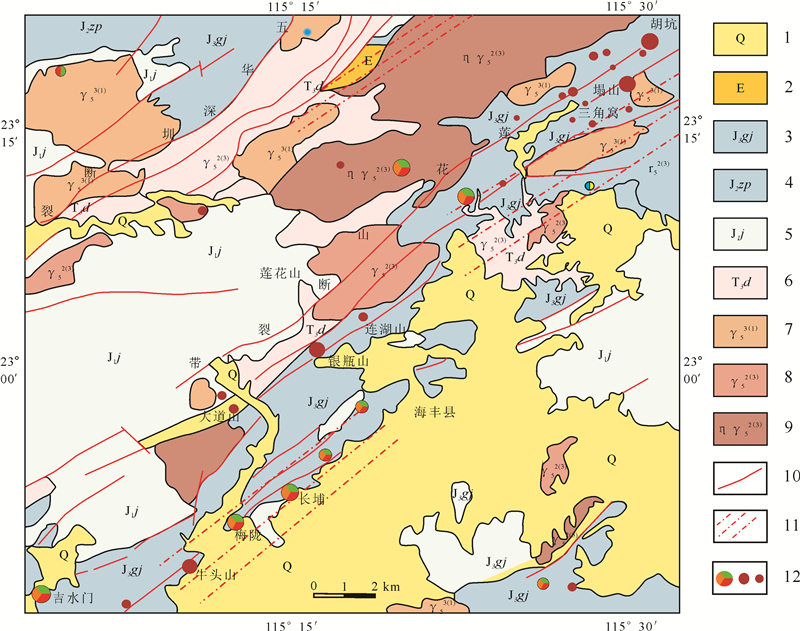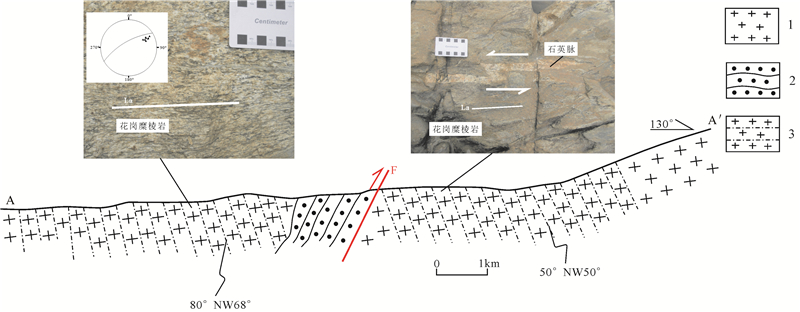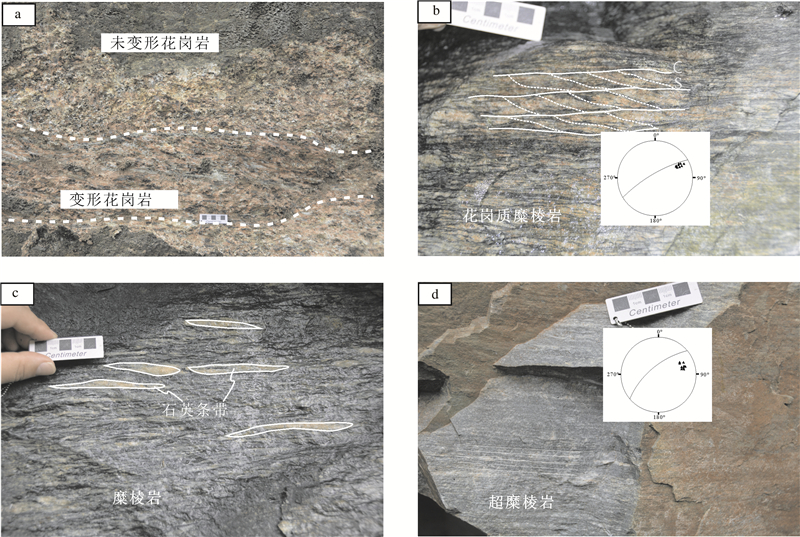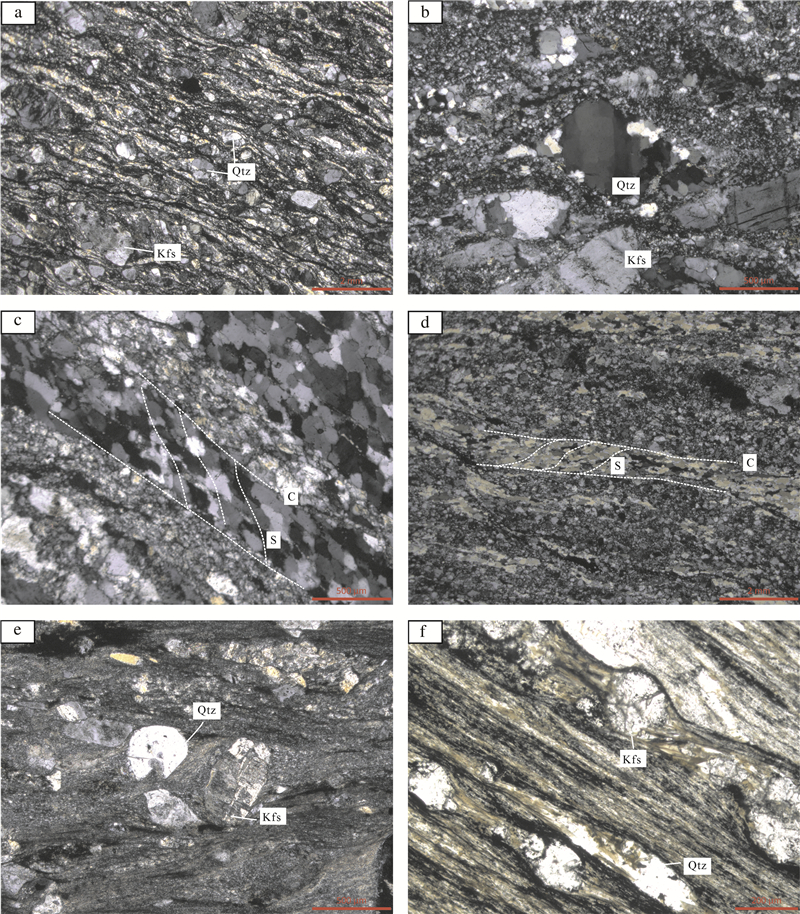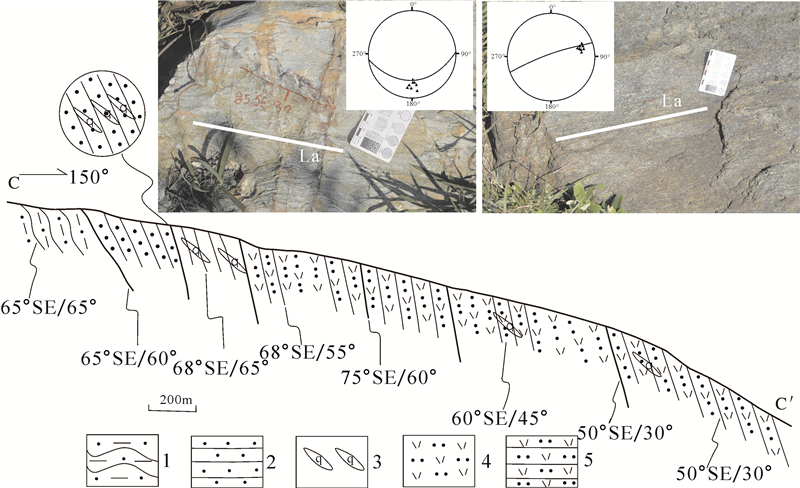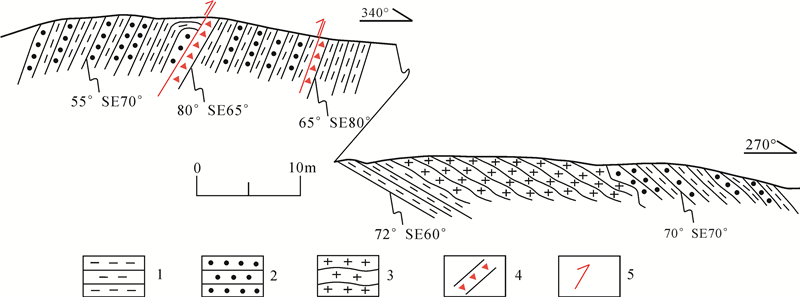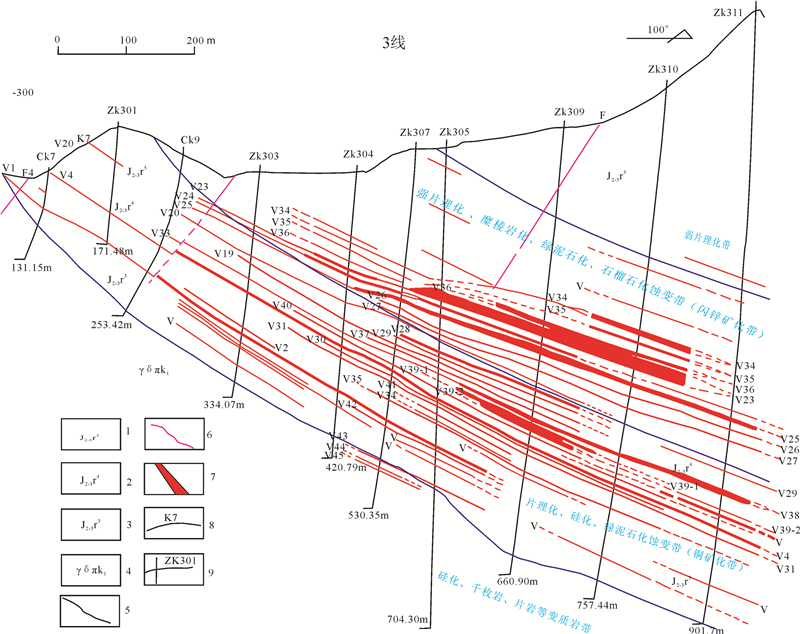The deformation characteristics of ductile shear zone and its relationship with mineralization in Lianhuashan fault zone, Guangdong Province
-
摘要:
莲花山断裂带是中国东南陆缘重要的NE向构造带。该断裂带不仅是区域上重要的二级构造单元分界线,也控制着广东省最重要的锡铜多金属成矿带。前人研究表明,莲花山断裂带内的韧性变形与锡铜多金属成矿关系密切,但对于莲花山断裂带内的韧性变形展布特征及其对成矿作用的贡献,还存在着较多争议。本次研究,通过对莲花山断裂带进行大比例尺的矿田构造填图,实测典型地质剖面等手段,结合拉伸线理产状的测量和显微构造的观察,认为断裂带内的韧性变形由自北向南一系列近NE60°走向的剪切带雁列展布而成,各剪切带之间呈大致平行展布。在韧性变形之后,这些雁列状的剪切带又被30°走向的脆性断层所切割。莲花山断裂带内的韧性变形控制着矿体的形态和规模,后期岩浆-热液活动利用先存韧性剪切带的空间,成矿元素在韧性变形的裂隙中沉淀富集成矿。莲花山断裂带内找矿勘探工作部署应该围绕断裂带内韧性变形的区域,并注意韧性变形附近次一级的容矿裂隙。
Abstract:The Lianhuashan fault zone is an important NE-trending tectonic belt on the southeastern continental margin of China. It is not only an important boundary of secondary tectonic units but also controls the most important tin-copper polymetallic metallogenic belt in Guangdong Province. Previous studies show that the ductile deformation in Lianhuashan fault zone is closely related to the tin-copper polymetallic mineralization. However, there are still some disputes about the distribution of ductile deformation and its contribution to mineralization in Lianhuashan fault zone. In this study, by means of large-scale structural mapping and typical geological profiles of the Lianhuashan fault zone, in combination with the measurement of tensile lineation attitude and the observation of microstructure, the authors have reached the conclusion that the ductile deformation in the fault zone was formed by a series of in-situ shear zones striking nearly 60° in N-S direction, which are roughly parallel to each other. After ductile deformation, these shear zones were cut by brittle faults striking 30°. Ductile deformation controls the shape and scale of orebodies in Lianhuashan fault zone. In the late magmatic and hydrothermal activities, the space of preexisting ductile shear zone was utilized to precipitate and enrich metallogenic elements in the cracks of ductile deformation. The ore-prospecting work in Lianhuashan fault zone should be arranged around the ductile deformation area and should pay attention to the ore-hosting fractures near the ductile deformation.
-
1. 引言
莲花山断裂带位于广东省东部,呈NE向展布,其作为中国东南陆缘著名的深大断裂,具有明显多期活动的特征,是重要的二级构造单元分界线(李三忠等, 2017)。前人研究表明,莲花山断裂带区域上属于政和—大浦断裂的南西段(陶建华等, 1988; 舒良树等, 2002; Shu et al., 2006, 2008; 夏玲燕等, 2019),主体为一条强烈的挤压破碎带,由120多条中小型断裂所组成(李建超等, 1990; 邱元喜等, 1991)(图 1),断裂带内硅化、糜棱岩化和片理化发育,动力变质作用和热接触变质作用强烈。前人对该断裂带内的韧性变形特征,变形时代、变形机制以及动力变质作用,都做过相应的研究,得出了诸多有意义的结论(邹和平等, 2000; 郭瑞, 2008; 杜继宇, 2012; 王霄飞等, 2014; 汪礼明等, 2018)。如邹和平等(2000)利用单矿物Ar-Ar年龄,认为莲花山韧性剪切带经历了3次构造-热事件; 杜继宇等(2012)认为莲花山断裂带在中生代分别经历了早白垩世中期、早白垩世末期—晚白垩世早期两期走滑热事件,其构造属性为一条大型左行走滑韧性剪切带; 汪礼明等(2018)认为莲花山断裂带内分布着4个动力变质带,存在着巨大的找矿潜力。这些工作对提高莲花山断裂带的研究程度以及区域找矿方向等方面均具有明显的参考价值。
![]() 图 1 广东省莲花山断裂带区域地质图(据汪礼明等,2018修改)1—燕山期侵入岩; 2—地台褶皱盖层; 3—沉积盆地; 4—大型断层; 5—背斜、向斜; 6—韧性变形带Figure 1. Geological map of Lianhuashan fault zone, Guangdong Province (modified from Wang Liming et al., 2018)1- Yanshanian intrusive rock; 2-Platform fold caprock; 3-Sedimentary basin; 4-Large fault; 5- Anticline, syncline; 6- Ductile deformation zone
图 1 广东省莲花山断裂带区域地质图(据汪礼明等,2018修改)1—燕山期侵入岩; 2—地台褶皱盖层; 3—沉积盆地; 4—大型断层; 5—背斜、向斜; 6—韧性变形带Figure 1. Geological map of Lianhuashan fault zone, Guangdong Province (modified from Wang Liming et al., 2018)1- Yanshanian intrusive rock; 2-Platform fold caprock; 3-Sedimentary basin; 4-Large fault; 5- Anticline, syncline; 6- Ductile deformation zone近年来,随着国家整装勘查项目的实施,莲花山断裂带内不断取得找矿突破,已经逐渐成为广东省最重要的锡铜多金属成矿带(Mao et al., 2013; 汪礼明等,2018)。据不完全统计,该带已发现的各类多金属矿床达200多处(图 2),其中半数以上属于锡石硫化物矿床和斑岩型矿床(丘增旺等, 2016, 2017; 闫庆贺等, 2018),特别是新近取得突破的揭西金坑铜锡多金属矿床更为莲花山断裂带内的锡铜找矿提供了更广阔的空间(丘增旺等, 2014; 钱龙兵等, 2017; 朱沛云等, 2018)。
![]() 图 2 莲花山断裂带南西段矿产分布图(据汪礼明等,2018修改)1—第四系; 2—古近系; 3—上侏罗统高基坪群; 4—中侏罗统漳平组; 5—下侏罗统金鸡组; 6—上三叠统大顶组; 7—燕山四期中细粒黑云母花岗岩; 8—燕山三期黑云母花岗岩; 9—燕山三期二长花岗岩; 10—实、推测断层; 11—韧性变形带; 12—大中型矿床Figure 2. Mineral distribution map of southwest Lianhuashan fault zone (modified from Wang Liming et al., 2018)1-Quaternary; 2- Paleogene; 3- Gaojiping Group of upper Jurassic; 4-Zhangping Formation of middle Jurassic; 5-Jinji Formation of lower Jurassic; 6-Dading Formation of upper Triassic; 7-Biotite granite of Yanshan fourth period; 8-Biotite granite of Yanshanian third period; 9-Monzogranite of Yanshanian third period; 10- Real and inferred faults; 11-Ductile deformation zone; 12-Large and medium-sized deposit
图 2 莲花山断裂带南西段矿产分布图(据汪礼明等,2018修改)1—第四系; 2—古近系; 3—上侏罗统高基坪群; 4—中侏罗统漳平组; 5—下侏罗统金鸡组; 6—上三叠统大顶组; 7—燕山四期中细粒黑云母花岗岩; 8—燕山三期黑云母花岗岩; 9—燕山三期二长花岗岩; 10—实、推测断层; 11—韧性变形带; 12—大中型矿床Figure 2. Mineral distribution map of southwest Lianhuashan fault zone (modified from Wang Liming et al., 2018)1-Quaternary; 2- Paleogene; 3- Gaojiping Group of upper Jurassic; 4-Zhangping Formation of middle Jurassic; 5-Jinji Formation of lower Jurassic; 6-Dading Formation of upper Triassic; 7-Biotite granite of Yanshan fourth period; 8-Biotite granite of Yanshanian third period; 9-Monzogranite of Yanshanian third period; 10- Real and inferred faults; 11-Ductile deformation zone; 12-Large and medium-sized deposit但是,随着勘探工作的深入,莲花山断裂带内的构造发展演化次序,构造与岩浆作用、成矿作用的关系,特别是韧性变形与锡铜多金属矿的相互关系,出现了较多争议。汪礼明等(2018)认为莲花山断裂带内晚侏罗世的左行剪切动力变质作用是成矿的主要驱动力,研究区为动力变质热液成矿; 丘增旺等(2016)认为研究区的陶锡湖和长浦等矿床的形成都与古太平洋板块向欧亚大陆俯冲作用有关,成矿具有区域伸展的动力学背景。本次研究,结合莲花山断裂带内北、中、南3个典型矿集区的分布特征,通过对莲花山断裂带进行大比例尺的矿田构造填图,实测典型地质剖面等手段,对莲花山断裂带的北、中、南3个部分进行详细的几何学,运动学及动力学的研究,理清断裂带内韧性变形的分布范围,查明区内主要控矿构造特征,探讨韧性剪切带与锡铜多金属成矿的关系,为研究区下一步找矿方向提供依据。
2. 区域地质背景
莲花山断裂带位于NE向东南沿海岩浆岩带与南岭EW向构造岩浆岩带交汇部位(徐晓春和岳书仓, 1999; Li and Li, 2007)。断裂带内发育中生代及及新生代地层,其中以侏罗系、下白垩统及第四系最为发育(张莉等, 2014)。上三叠统主要为碎屑岩建造,分布范围较小; 侏罗系下统与上三叠统为整合接触,发育一套以浅海相为主的碎屑岩建造; 侏罗系上统高基坪群为陆相中酸性火山岩建造,以喷发不整合上覆于下伏地层之上,为粤东沿海火山岩带的主要组成部分; 下白垩统官草湖组在断裂带内呈串珠状盆地分布,岩性为凝灰质碎屑岩为主,夹火山熔岩为特征。侏罗系上、下统为锡铜多金属矿的主要含矿层位。粤东地区中生代岩浆活动强烈,出露大量的火山岩-侵入岩。晚侏罗世岩浆活动最为剧烈,其次为早白垩世,早中侏罗世和晚白垩世岩浆岩分布较少。晚侏罗世—早白垩世主要出露一套英安质-流纹质火山岩及其相应的侵入岩组合,属于I-S过渡型花岗质火山-侵入杂岩(Xu et al., 2000)。研究区的构造形迹按其展布方向总体可以分为3组:NE-NNE向,NW向以及EW向。NE—NNE向构造形迹由一系列动力变质带,褶皱构造和压扭性断裂组成,NW向构造形迹为走向300°左右的以张扭性为主的断裂构造,EW向为一系列近东西走向的挤压带和冲断裂,其形迹不甚发育。
前人资料显示,莲花山断裂带内的侵入岩分布主要受NE向及其配套的NW向的断裂带控制(李三忠等, 2018),断裂带内发育强烈的片理化和糜棱岩化,主体经历了3期构造应力场的转换:中—晚侏罗世构造表现为深层次的逆冲、褶皱和动力热变质,指示为NW-SE向挤压构造应力场(丘元禧等,1991); 晚侏罗世—早白垩世构造表现为NE向的左行韧性剪切变形,形成莲花山断裂带主体的NE向构造形迹,并伴随着大量的火山喷发和岩浆侵入,指示着构造应力场由挤压向伸展的过渡阶段(宋传中等,2019); 中白垩世以来,莲花山断裂带以伸展作用为主,形成一系列晚白垩世的拉分盆地,并导致先期压扭性断层重新活动,形成较多张性断层(邱元禧等, 1991; 邹和平等, 2000)。莲花山断裂带内的这种复杂的构造应力场转化为岩浆侵位、含矿流体的运移以及成矿物质的沉淀提供了良好的通道和空间,强烈影响着断裂带内诸多矿体的规模和定位。
3. 莲花山断裂带北段韧性变形特征
3.1 平面展布特征
莲花山断裂带北带韧性变形分布在龙村—五华—安流一带。在五华县安流镇附近,韧性剪切带出露较好,原岩为燕山期花岗岩(图 1)。通过大比例尺填图来看,莲花山断裂带北段韧性变形的范围长40 km左右,宽不超过10 km,总体呈NE60°方向产出,韧性变形呈明显的强弱不均的特征产出。本次研究沿油田—郭田进行构造剖面测量,剖面从南东向北西方向,剖面中花岗质糜棱岩中面理发育,倾向北西,为318°~330°,倾角较缓,一般为20°~30°(图 3)。糜棱岩中可见石英和长石定向拉长,局部可见石英脉发生褶曲,指示左旋走滑特征(图 3)。越靠近韧性剪切带中心部位,岩石变形越强,遭受剪切细粒化作用越明显,残斑数量也越少,长石定向拉长的现象也越明显。韧性剪切带的中心可见超糜棱岩,超糜棱岩中基质含量大于90%,残斑少见。从花岗质初糜棱岩到超糜棱岩,粒度逐渐变细,基质含量逐渐增多,残斑的数量依次减少,直至过渡到超糜棱岩,呈现出从边缘向韧性剪切带中心连续的递进变形。
3.2 韧性变形显微构造特征
莲花山韧性剪切带内花岗质糜棱岩,根据剪切程度的不同,具有明显的分带性。根据糜棱岩内基质的含量,自韧性剪切带边部向中心依次为糜棱岩化花岗岩→花岗质初糜棱岩→花岗质糜棱岩→花岗质超糜棱岩,呈现出韧性变形逐渐增强的趋势。受韧性剪切变形变质作用的影响,可见带内岩石粒度明显减小,残斑主要为长石,镜下可见石英塑性拉长,构成S面理,新生云母发育,并定向排列,构成C面理,S-C组构及长石残斑显示左行剪切特征。
4. 莲花山断裂带中段韧性变形特征
4.1 平面展布特征
莲花山断裂带中段韧性变形分布在苏区—陆河—河口—黄羌镇一带,带宽1~5 km,走向北东50°方向,延伸长度50 km左右,韧性变形在花岗岩中表现为糜棱岩,在变质岩或沉积岩中则表现为硅化带,劈理密集发育等特征(图 4)。在陆河南告水库附近,韧性剪切带出露较好,在花岗岩内发育花岗糜棱岩带,带内可见糜棱岩化花岗岩、眼球状花岗糜棱岩和超糜棱岩相间发育(图 5a)。岩石具有明显的定向重结晶,动力分异明显,可形成波状弯曲的黑白条纹,具有明显塑形变形的特征(图 5c)。剖面中糜棱岩面理倾向在310°~345°,中高角度倾斜,倾角在50°~70°变化(图 5b、d),具有左旋走滑特征。在沉积岩中则发育一系列与层理斜交,产状与糜棱岩面理近一致的劈理面。沿劈理面可见透镜状的石英脉分布。
![]() 图 4 莲花山断裂带中段苏区—陆河(B-B’)构造变形剖面(剖面位置见图 1)1—晶屑凝灰岩; 2—花岗岩; 3—石英砂岩; 4—石英斑岩脉; 5—片理化晶屑凝灰岩; 6—糜棱岩化Figure 4. Structural profile of Suqu - Luhe (B-B ') in the middle part of Lianhuashan fault zone (section position see Fig. 1)1-Crystalline tuff; 2-Granite; 3-Sandstone; 4-Quartz porphyry vein; 5- Flake crystalline tuff; 6- Mylonitization
图 4 莲花山断裂带中段苏区—陆河(B-B’)构造变形剖面(剖面位置见图 1)1—晶屑凝灰岩; 2—花岗岩; 3—石英砂岩; 4—石英斑岩脉; 5—片理化晶屑凝灰岩; 6—糜棱岩化Figure 4. Structural profile of Suqu - Luhe (B-B ') in the middle part of Lianhuashan fault zone (section position see Fig. 1)1-Crystalline tuff; 2-Granite; 3-Sandstone; 4-Quartz porphyry vein; 5- Flake crystalline tuff; 6- Mylonitization![]() 图 5 莲花山断裂带中段变形岩石野外露头照片a—变形花岗岩与未变形花岗岩相间产出; b—花岗质糜棱岩中的S—C组构; c—糜棱岩中拉长的石英条带; d—超糜棱岩,岩石发生强烈细粒化Figure 5. The typical photos of deformed rocks in the middle section of Lianhuashan fault zonea- Deformed granite and undeformed granite produced interphase; b- S-C fabric in granitic mylonites; c- An elongated band of quartz in mylonite; d- Supermy lonite, the rocks subjected to intense granulation
图 5 莲花山断裂带中段变形岩石野外露头照片a—变形花岗岩与未变形花岗岩相间产出; b—花岗质糜棱岩中的S—C组构; c—糜棱岩中拉长的石英条带; d—超糜棱岩,岩石发生强烈细粒化Figure 5. The typical photos of deformed rocks in the middle section of Lianhuashan fault zonea- Deformed granite and undeformed granite produced interphase; b- S-C fabric in granitic mylonites; c- An elongated band of quartz in mylonite; d- Supermy lonite, the rocks subjected to intense granulation4.2 显微构造特征
在莲花山断裂带发育的糜棱岩中,既可见到长石的脆性变形显微构造现象,也可见到长石的韧性变形显微构造现象。在韧性变形相对较弱的部位,长石常形成脆性碎裂的书斜构造(或称为多米诺骨牌现象),书斜构造的长石斜列特征显示剪切方向为左行。在韧性变形相对较强的部位,长石常被塑性拉长,并沿C面理方向定向排列。在韧性变形最强部位,即韧性剪切带的中心,岩石细粒化最为明显,形成超糜棱岩(图 8),岩石中几乎不存在长石残斑,S-C组构不发育。
![]() 图 8 莲花山断裂带内韧性变形岩石镜下典型照片a—花岗质糜棱岩中长石、石英残斑; b—糜棱岩中石英核幔构造,原岩为花岗岩; c、d—糜棱岩中石英的S-C组构,原岩为花岗岩; e—凝灰岩中石英和长石晶屑; f—凝灰岩中拉长变形的石英条带; Kfs—钾长石; Qtz—石英Figure 8. Microscope photos of ductile deformation rocks in Lianhuashan fault zonea- Feldspar and quartz remnant spots in granitic mylonite; b- The core - mantle structure in mylonite, the original rock is granite; c d- S-C fabric in mylonites, the original rock is granite; e- Quartz and feldspar in tuff; f- Elongated bands of quartz in tuff; kfs-K-feldspar; Qtz-Quartz
图 8 莲花山断裂带内韧性变形岩石镜下典型照片a—花岗质糜棱岩中长石、石英残斑; b—糜棱岩中石英核幔构造,原岩为花岗岩; c、d—糜棱岩中石英的S-C组构,原岩为花岗岩; e—凝灰岩中石英和长石晶屑; f—凝灰岩中拉长变形的石英条带; Kfs—钾长石; Qtz—石英Figure 8. Microscope photos of ductile deformation rocks in Lianhuashan fault zonea- Feldspar and quartz remnant spots in granitic mylonite; b- The core - mantle structure in mylonite, the original rock is granite; c d- S-C fabric in mylonites, the original rock is granite; e- Quartz and feldspar in tuff; f- Elongated bands of quartz in tuff; kfs-K-feldspar; Qtz-Quartz5. 莲花山断裂带南段韧性变形特征
5.1 平面展布特征
莲花山断裂带南段韧性变形分布在莲花山—海丰—平海一带,宽度较小,在1~2 km范围内,走向北东40°~50°,延伸长度70 km左右,不同地段分别切割了花岗岩和火山岩,其南端潜于海底水下。在鲘门镇,韧性剪切带主要分布在晚侏罗世—早白垩世南山村组火山岩之中,原岩岩性以英安质火山碎屑岩、流纹质火山碎屑岩为主。受韧性剪切带的影响,原岩中晶屑、岩屑和火山角砾强烈拉长定向,岩石变质变形成为糜棱岩或糜棱岩化火山岩。剪切带岩石中新生云母等片状矿物定向成面理,产状非常稳定,倾向在140°~160°,倾角在55°~70°(图 6)。岩石中晶屑、岩屑和火山角砾形成的旋转残斑及S-C组构指示韧性剪切带具有左行走滑的特征。
![]() 图 6 莲花山断裂带南段梅陇地区(C-C’)构造变形剖面及典型照片(剖面位置见图 1)1—云母石英片岩; 2—石英砂岩; 3—石英脉; 4—晶屑凝灰岩; 5—片理化晶屑凝灰岩Figure 6. Structural profile and typical photos of Meilong area (C-C ') in the southern part of Lianhuashan fault zone (section position see Fig. 1)1- Mica quartz schist; 2-Sandstone; 3-Quartz vein; 4- Crystalline tuff; 5- Flake crystalline tuff
图 6 莲花山断裂带南段梅陇地区(C-C’)构造变形剖面及典型照片(剖面位置见图 1)1—云母石英片岩; 2—石英砂岩; 3—石英脉; 4—晶屑凝灰岩; 5—片理化晶屑凝灰岩Figure 6. Structural profile and typical photos of Meilong area (C-C ') in the southern part of Lianhuashan fault zone (section position see Fig. 1)1- Mica quartz schist; 2-Sandstone; 3-Quartz vein; 4- Crystalline tuff; 5- Flake crystalline tuff此外,在韧性变形内部,可见侵入产出的石英斑岩岩脉,岩脉发生明显的韧性变形(图 7),说明在岩脉产出后,地层发生过剪切变形。在泥岩或砂岩中,韧性变形表现不明显,但在地层中,可见较多小型的逆冲断层(图 7),可能代表着剪切变形超过岩石破裂极限后的调节作用。
5.2 显微构造特征
韧性剪切带主要发育在晚侏罗世—早白垩世南山村组火山岩中,变质变形原岩为中酸性火山碎屑岩,受韧性剪切带的影响,岩石变质变形为糜棱岩化火山岩或糜棱岩。糜棱岩中肉眼可见明显晶屑、岩屑和火山角砾等定向拉长,镜下最明显特征则为新生云母定向排列构成C面理,而火山碎屑岩中晶屑、岩屑等则主要以晶屑残斑和岩屑残斑的形式存在(图 8e、f)。其中晶屑残斑以长石残斑为主,少量石英残斑; 岩屑残斑主要为长英质成分为主的流纹岩。残斑尾部的形态特征指示韧性剪切带为左行剪切。另外,莲花山断裂带火山质糜棱岩中也可见到压力影和核幔构造等韧性变形现象。
综上所述,莲花山断裂带内的韧性变形在花岗岩体中表现为从边缘向中心由变晶花岗岩→片麻岩→初糜棱岩→糜棱岩→超糜棱岩的递增变形序列。韧性变形较强的剪切带中心部位发育A型线理,动态重结晶和核幔构造,有超糜棱岩出现。韧性变形较弱的剪切带仅可见暗色矿物的定向排列,仅发育初糜棱岩。韧性变形形成的拉伸线理方位稳定,倾伏角在20°左右,平面上莲花山断裂带南西段的韧性变形自北向南呈雁列状展布,走向为60°左右,韧性剪切带之间呈大致平行展布。判断莲花山断裂南西段在晚中生代时期经历了两期变形。早期韧性变形断裂走向为60°左右,在地层和岩体之间都有表现。在野外填图过程中,可见韧性变形带与脆性断层呈明显突变的关系,垂直脆性断层走向另一侧,未见明显的韧性变形的特征,结合区域上30°走向脆性断层的分布特征,本次研究认为30°走向的脆性断层为研究区较晚的一次构造变形,该期构造变形切穿了韧性剪切带。
6. 韧性剪切带与成矿关系探讨
前文已述,莲花山断裂带是一个以锡、铜为主的多金属成矿带。从目前已知的勘探资料分析,可以看出莲花山断裂带内,矿点的分布、矿化强弱规律与韧性变形的强弱具有一定程度的正相关关系。断裂带内的锡铜多金属矿脉,常常受控于韧性剪切带与动力热变质带之中。一般认为,韧性剪切带和动力热变质带为锡铜多金属沉淀提供了容矿空间。但韧性变形过程能否导致矿源层的锡铜多金属活化?韧性剪切活动与断裂带内后期的热液成矿作用有何相关关系?一直都是众多学者关注的问题。
莲花山断裂带北侧韧性变形带控制着金坑锡铜多金属矿的产出。在金坑矿区,可见大规模的糜棱岩化带及片理化带。在平面上,韧性变形较强的部位,是矿区矿化最好的地段,往两侧片理化带中矿化逐渐减弱; 在垂向上,以矿区3号勘探线为例,浅部片理化带矿化较弱,中部糜棱岩化带矿体集中分布,深部片理化带中,矿化又逐渐减弱(图 9)。在钻孔和镜下,可见金属矿物沿岩石裂隙充填或在矿物颗粒边部薄弱部位沉淀富集(图 10c),局部可见黄铜矿在闪锌矿中的静态出溶现象(图 10d)。上述特征显示,韧性剪切带作为重要的控矿构造,韧性剪切作用先期形成的成矿结构面,经历过后期的张开活化,为矿液的运移、沉淀及富集提供了通道和空间。
![]() 图 9 金坑矿区3号勘探线剖面图(据朱沛云等,2018)1—侏罗系上统热水洞组第五段; 2—侏罗系上统热水洞组第四段; 3—侏罗系上统热水洞组第三段; 4—早白垩世花岗闪长斑岩; 5—实测及推测构造地质界线; 6—实测及推测断层破碎带; 7—矿脉及编号; 8—槽探及编号; 9—钻孔位置及编号Figure 9. Geological profile along No. 3 exploration line in the Jinkeng mining area (after Zhu Peiyun et al., 2018)1-The fifth member of reshuidong Formation, upper Jurassic; 2- The fourth member of reshuidong Formation, upper Jurassic; 3-The third member of Reshuidong Formation, upper Jurassic; 4- Granodiorite porphyry of early Cretaceous; 5-Measuredl and inferred geological boundaries; 6-Measured and inferred fault; 7- Vein and its serial number; 8- Trenching and its serial number; 9- Drill hole location and serial number
图 9 金坑矿区3号勘探线剖面图(据朱沛云等,2018)1—侏罗系上统热水洞组第五段; 2—侏罗系上统热水洞组第四段; 3—侏罗系上统热水洞组第三段; 4—早白垩世花岗闪长斑岩; 5—实测及推测构造地质界线; 6—实测及推测断层破碎带; 7—矿脉及编号; 8—槽探及编号; 9—钻孔位置及编号Figure 9. Geological profile along No. 3 exploration line in the Jinkeng mining area (after Zhu Peiyun et al., 2018)1-The fifth member of reshuidong Formation, upper Jurassic; 2- The fourth member of reshuidong Formation, upper Jurassic; 3-The third member of Reshuidong Formation, upper Jurassic; 4- Granodiorite porphyry of early Cretaceous; 5-Measuredl and inferred geological boundaries; 6-Measured and inferred fault; 7- Vein and its serial number; 8- Trenching and its serial number; 9- Drill hole location and serial number莲花山断裂中部韧性变形带内的典型矿床为江西坑锡多金属矿,江西坑矿区的地表和钻孔中均显示,矿化蚀变和韧性变形都具有明显的分带性。石榴石和十字石蚀变带均与糜棱岩化和片理化密切相关。在钻孔中,可见韧性变形的石榴子石,也存在自形程度良好的石榴子石(图 10a、b),表明在韧性剪切作用之后仍存在至少一期热液活动,也说明韧性剪切带为成矿提供了空间。
断裂带南部的韧性变形带内产出有长埔锡矿(朱沛云等, 2017),矿区地表可见大规模的糜棱岩化带及片理化带,卷入该期韧性剪切变形的岩石包括下侏罗统长埔组碎屑岩和上侏罗统—下白垩统的南山村组火山岩,韧性剪切带控制了矿体的形态和规模,矿化主要集中在糜棱岩带的裂隙中,倾向130°~155°,倾角45°~60°的节理对成矿最为重要,经多次活动张开,充填了锡石石英脉、硫化物细脉以及无矿石英脉等,是构成细脉浸染型矿石的主要裂隙构造。
通过总结莲花山断裂带内韧性剪切带与成矿的相互关系,本次研究认为,韧性剪切变形过程中,可能存在着一定规模的流体运移,并影响着成矿物质的迁移,但后期的岩浆-热液活动,利用了先存韧性剪切带的空间,进一步萃取韧性剪切带中初步富集的锡多金属元素而成矿。因此,莲花山断裂带内的勘探工作应围绕韧性变形的区域展开,并注意韧性变形带附近的次一级裂隙。
7. 结论
(1)通过对莲花山断裂带内北、中、南三部分韧性变形的几何学和运动学的详细研究,认为断裂带内的韧性变形由自北向南一系列走向60°的剪切带雁列展布而成,各剪切带之间呈大致平行展布。在韧性变形之后,这些雁列状的剪切带又被走向30°的脆性断层所切割。
(2)莲花山断裂带内的韧性变形控制着矿体的形态和规模,后期岩浆-热液活动利用先存韧性剪切带的空间,成矿元素在韧性变形的裂隙中沉淀富集成矿。
致谢: 野外工作期间得到了广东有色金属地质局九三一队卜安、许典葵等的帮助;评审专家及编辑对论文提出了宝贵的修改意见,在此一并表示衷心的感谢! -
图 1 广东省莲花山断裂带区域地质图(据汪礼明等,2018修改)
1—燕山期侵入岩; 2—地台褶皱盖层; 3—沉积盆地; 4—大型断层; 5—背斜、向斜; 6—韧性变形带
Figure 1. Geological map of Lianhuashan fault zone, Guangdong Province (modified from Wang Liming et al., 2018)
1- Yanshanian intrusive rock; 2-Platform fold caprock; 3-Sedimentary basin; 4-Large fault; 5- Anticline, syncline; 6- Ductile deformation zone
图 2 莲花山断裂带南西段矿产分布图(据汪礼明等,2018修改)
1—第四系; 2—古近系; 3—上侏罗统高基坪群; 4—中侏罗统漳平组; 5—下侏罗统金鸡组; 6—上三叠统大顶组; 7—燕山四期中细粒黑云母花岗岩; 8—燕山三期黑云母花岗岩; 9—燕山三期二长花岗岩; 10—实、推测断层; 11—韧性变形带; 12—大中型矿床
Figure 2. Mineral distribution map of southwest Lianhuashan fault zone (modified from Wang Liming et al., 2018)
1-Quaternary; 2- Paleogene; 3- Gaojiping Group of upper Jurassic; 4-Zhangping Formation of middle Jurassic; 5-Jinji Formation of lower Jurassic; 6-Dading Formation of upper Triassic; 7-Biotite granite of Yanshan fourth period; 8-Biotite granite of Yanshanian third period; 9-Monzogranite of Yanshanian third period; 10- Real and inferred faults; 11-Ductile deformation zone; 12-Large and medium-sized deposit
图 4 莲花山断裂带中段苏区—陆河(B-B’)构造变形剖面(剖面位置见图 1)
1—晶屑凝灰岩; 2—花岗岩; 3—石英砂岩; 4—石英斑岩脉; 5—片理化晶屑凝灰岩; 6—糜棱岩化
Figure 4. Structural profile of Suqu - Luhe (B-B ') in the middle part of Lianhuashan fault zone (section position see Fig. 1)
1-Crystalline tuff; 2-Granite; 3-Sandstone; 4-Quartz porphyry vein; 5- Flake crystalline tuff; 6- Mylonitization
图 5 莲花山断裂带中段变形岩石野外露头照片
a—变形花岗岩与未变形花岗岩相间产出; b—花岗质糜棱岩中的S—C组构; c—糜棱岩中拉长的石英条带; d—超糜棱岩,岩石发生强烈细粒化
Figure 5. The typical photos of deformed rocks in the middle section of Lianhuashan fault zone
a- Deformed granite and undeformed granite produced interphase; b- S-C fabric in granitic mylonites; c- An elongated band of quartz in mylonite; d- Supermy lonite, the rocks subjected to intense granulation
图 8 莲花山断裂带内韧性变形岩石镜下典型照片
a—花岗质糜棱岩中长石、石英残斑; b—糜棱岩中石英核幔构造,原岩为花岗岩; c、d—糜棱岩中石英的S-C组构,原岩为花岗岩; e—凝灰岩中石英和长石晶屑; f—凝灰岩中拉长变形的石英条带; Kfs—钾长石; Qtz—石英
Figure 8. Microscope photos of ductile deformation rocks in Lianhuashan fault zone
a- Feldspar and quartz remnant spots in granitic mylonite; b- The core - mantle structure in mylonite, the original rock is granite; c d- S-C fabric in mylonites, the original rock is granite; e- Quartz and feldspar in tuff; f- Elongated bands of quartz in tuff; kfs-K-feldspar; Qtz-Quartz
图 6 莲花山断裂带南段梅陇地区(C-C’)构造变形剖面及典型照片(剖面位置见图 1)
1—云母石英片岩; 2—石英砂岩; 3—石英脉; 4—晶屑凝灰岩; 5—片理化晶屑凝灰岩
Figure 6. Structural profile and typical photos of Meilong area (C-C ') in the southern part of Lianhuashan fault zone (section position see Fig. 1)
1- Mica quartz schist; 2-Sandstone; 3-Quartz vein; 4- Crystalline tuff; 5- Flake crystalline tuff
图 9 金坑矿区3号勘探线剖面图(据朱沛云等,2018)
1—侏罗系上统热水洞组第五段; 2—侏罗系上统热水洞组第四段; 3—侏罗系上统热水洞组第三段; 4—早白垩世花岗闪长斑岩; 5—实测及推测构造地质界线; 6—实测及推测断层破碎带; 7—矿脉及编号; 8—槽探及编号; 9—钻孔位置及编号
Figure 9. Geological profile along No. 3 exploration line in the Jinkeng mining area (after Zhu Peiyun et al., 2018)
1-The fifth member of reshuidong Formation, upper Jurassic; 2- The fourth member of reshuidong Formation, upper Jurassic; 3-The third member of Reshuidong Formation, upper Jurassic; 4- Granodiorite porphyry of early Cretaceous; 5-Measuredl and inferred geological boundaries; 6-Measured and inferred fault; 7- Vein and its serial number; 8- Trenching and its serial number; 9- Drill hole location and serial number
-
Du Jiyu. 2012. The Structural Features and Ages of Activities of Lianhuashan Fault and Changle-Nan'ao Fault[D]. Changchun: Jilin University. 1-52 (in Chinese with English abstract).
Guo Rui. 2008. Ore-forming Geologic Background and Ore-forming Feature of Ag-Cu-Pb-Zn, Eastern Guangdong, China[D]. Changsha: Central South University. 1-104 (in Chinese with English abstract).
Li Jianchao, Qiu Yuanxi. 1990. A preliminary study on the basic features of the fault dynamo-thermal metamorphic belt of the Lianhuashan and its genetic mechanism[J]. Journal of Changchun University of Earth Science, 20(1):11-20, 123(in Chinese with English abstract).
Li Sanzhong, Zang Yibo, Wang Pengcheng, Suo Yanhui, Li Xiyao, Liu Xin, Zhou, Zaizheng, Liu Xiaoguang, Wang Qian. 2017. Mesozoic tectonic transition in South China and initiation of Palaeo-Pacific subduction[J]. Earth Science Frontiers, 24(4):213-225(in Chinese with English abstract). http://www.wanfangdata.com.cn/details/detail.do?_type=perio&id=dxqy201704020
Li Sanzhong, Suo Yanhui, Li Xiyao, Wang Yongming, Cao Xianzhi, Wang Pengcheng, GuoLingli, Yu Shengyao, Lan Haoyuan, Li Shaojun, Zhao Shujuan, Zhou Zaizheng, Zhang Zhen, Zhang Guowei. 2018. Mesozoic plate subduction in West Pacific andtectono-magmatic response in the East Asianocean-continent connection zone[J]. Chinese Science Bulletin, 63(16):1550-1593(in Chinese). doi: 10.1360/N972017-01113
Li Zhengxiang, Li Xianhua. 2007. Formation of the 1300-km-wide intra-continental orogen and postorogenic magmatic province in Mesozoic South China:A flat-slab subduction model[J]. Geology, 35(2):179-182. http://ci.nii.ac.jp/naid/10026540735
Mao Jingwen, Cheng Yanbo, Chen Maohong, Pirajno F. 2013. Major types and time-space distribution of Mesozoic ore deposits in South China and their geodynamic settings[J]. Mineralium Deposita, 48(3):267-294. doi: 10.1007/s00126-012-0446-z
Qian Longbing, Guo Lirong, Yu Qingliang. 2017. Mineral prediction model of the integrative exploration area in the southwest section of the Lianhuashan fault zone, Guangdong Province[J]. Journal of Geology, 41(3):468-473(in Chinese with English abstract). http://www.wanfangdata.com.cn/details/detail.do?_type=perio&id=jsdz201703015
Qiu Yuanxi, Qiu Jinsong, Li Jianchao, Zhong Hongping. 1991. Deformational and metamorphic features of Lianhuashan fault zone during Meso-Cenozoic time and mechanism of their formation[J].Journal of Geomechanics, 1991:93-106(in Chinese with English abstract). http://en.cnki.com.cn/Article_en/CJFDTotal-DZLX199100007.htm
Qiu Zengwang, Wang He, Li Shasha, Li Pei, Wei Xiaopeng, Mu Shenglu. 2014. New progress in exploration and research of Jinkeng copper-tin-lead-zinc deposit in Jiexi County, Guangdong Province[J]. Mineral Deposits, (S1):955-956(in Chinese).
Qiu Zengwang, Wang He, Yan Qinghe, Li Shasha,, Wang Liming, Bu An, Mu Shenglu, Li Pei, Wei Xiaopeng. 2016. Zircon U-Pb geochronology and Lu-Hf isotopic composition of quartz porphyry in the Changpu Sn polymetallic deposit, Guangdong Province, SE China and their geological significance[J]. Geochimica, 45(4):374-386(in Chinese with English abstract). http://www.wanfangdata.com.cn/details/detail.do?_type=perio&id=dqhx201604003
Qiu Zengwang, Wang He, Yan Qinghe, Li Shasha, Wang Liming, Bu An, Wei Xiaopeng, Li Pei, Mu Shenglu. 2017. Zircon U-Pb geochronology, geochemistry and Lu-Hf isotopes of granite porphyry in TaoxihuTin polymetallic deposit, Guangdong Province, SE china and its geological significance[J]. Geotectonica et Metallogenia, 41(3):516-532(in Chinese with English abstract).
Shu Liangshu, Faure Michel, Jiang Shaoyong, Yang Qun, Wang Yujing. 2006. SHRIMP zircon U-Pb age, litho-and biostratigraphic analyses of the Huaiyu Domain in South China-Evidence for a Neoproterozoic orogen, not Late Paleozoic-Early Mesozoic collision[J]. Episodes, 29:244-252. doi: 10.18814/epiiugs/2006/v29i4/002
Shu Liangshu, Faure Michel, Wang Bo, Zhou Xinmin, Song Biao. 2008. Late Palaeozoic-Early Mesozoic geological features of South China:response to the Indosinian collision events in Southeast Asia[J]. ComptesRendus Geoscience, 340(2/3):151-165. https://www.academia.edu/13137671/Late_Palaeozoic_Early_Mesozoic_geological_features_of_South_China_Response_to_the_Indosinian_collision_events_in_Southeast_Asia
Song Chuanzhong, Li Jiahao, Yan Jiayong, Wang Yangyang, Liu Zhendong, Yuan Fang, Li Zhenwei. 2019. A tentative discussion on some tectonic problems in the east of South China continent[J]. Geology in China, 46(4):704-722(in Chinese with English abstract). http://www.wanfangdata.com.cn/details/detail.do?_type=perio&id=zgdizhi201904003
Suo Yanhui, Li Sanzhong, Dai Liming, Liu Xin, Zhou Lihong. 2012. Cenozoic tectonic migration and basin evolution in East Asia and its continental margins[J]. Acta Petrologica Sinica, 28(8):2602-2618(in Chinese with English abstract). http://en.cnki.com.cn/Article_en/CJFDTOTAL-YSXB201208026.htm
Tao Jianhua. 1988. Features of ductile shear zone in the middle part of Zhenghe-Dapu fault[J]. Geology of Fujian, (3):196-204, 258-261(in Chinese with English abstract). http://en.cnki.com.cn/Article_en/CJFDTOTAL-FJDZ198803003.htm
Wang Liming, Wang Jun, Wang He, Bu An, Li Shasha, Qian Longbing, Wang Wei. 2018. Dynamic metamorphism origin for the tin-copper polymetallic mineralization in the Lianhuashan fault, eastern Guangdong Province[J]. Geotectonica et Metallogenia, 42(5):908-917(in Chinese with English abstract). http://www.wanfangdata.com.cn/details/detail.do?_type=perio&id=ddgzyckx201805011
Wang Xiaofei, Yu Shan, Gong Yuehua, Li Sanzhong, Liu Xin, Ma Yun, Zhao Shujuan. 2014. Extension of NE-trending faults in south China to northern south China Sea continental shelf[J]. Geotectonica et Metallogenia, 38(3):557-570(in Chinese with English abstract). http://www.wanfangdata.com.cn/details/detail.do?_type=perio&id=ddgzyckx201403006
Xia Lingyan, Lin Changsong, Li Xiao, Hu Yue. 2019. A study of extension of Lianhuashan fault in Guangdong to adjacent marine space based on remote sensing and aeromagnetic data[J]. Remote Sensing for Land & Resources, 31(1):247-254(in Chinese with English abstract). http://www.wanfangdata.com.cn/details/detail.do?_type=perio&id=gtzyyg201901032
Xu Xiaochun, YueShucang. 1999. Source material and metallization of tin (tungsten, copper) polymetallic deposits in eastern Guangdong Province[J]. Scientia Geologica Sinica, 34(1):81-92(in Chinese with English abstract). http://en.cnki.com.cn/Article_en/CJFDTotal-DZKX901.008.htm
Xu Xiaochun, Xie Qiaoqin, YueShucang. 2000. Mesozoic volcanic and intrusive rocks in eastern Guang dong province China:Genesis, types and petrologic implication[J]. Scientia Geologica Sinica, 9(3):253-262. http://www.cnki.com.cn/Article/CJFDTotal-DZKY200003001.htm
Yan Qinghe, Wang He, Qiu Zengwang, Wang Min, Mu Shenglu, Wang Liming, Bu An, Wang Saimeng, Li Shasha, Wei Xiaopeng, Li Pei. 2018. Zircon and Cassiterite U-Pb Ages and Lu-Hf Isotopic Compositions of Tashan Tin-bearing Porphyry in Guangdong Province, SE China and its Geological Significance[J]. Geotectonica et Metallogenia, 42(4):718-731(in Chinese with English abstract). http://www.wanfangdata.com.cn/details/detail.do?_type=perio&id=ddgzyckx201804010
Zhang Li, Zeng Weijun, Wei Zhenquan, Lin Zhen, Lei Zhenyu, Shuai Qingwei. 2014. The impact of northern South China Sea paleotectonic framework on development of Mesozoic and Cenozoic[J]. Earth Science Frontiers, 21(6):254-263(in Chinese with English abstract). http://www.wanfangdata.com.cn/details/detail.do?_type=perio&id=dxqy201406025
Zhu Peiyun, Bu An, Yan Lunming, Qian Longbing. 2017. Geological characteristics and prospecting indication of Changpu tin deposit, Haifeng County, Guangdong Province[J]. Western Resources, 2017(3):37-38, 197(in Chinese).
Zhu Peiyun, Yan Lunming, Bu An, Xu Diankui, Qian Longbing, Guo lirong. 2018. Research on the mineralization geological body in Jinkeng copper-tin-lead-zinc deposit, Guangdong[J]. Mineral Exploration, 9(1):33-44(in Chinese with English abstract). http://www.wanfangdata.com.cn/details/detail.do?_type=perio&id=ytgcj201801006
Zou Heping, Wang Jianhua, QiuYuanxi. 2000.40Ar/39Ar ages of the Nan'ao Shear Zone and the Lianhuashan Shear Zone in Guangdong Province and Their Geological Significance[J]. Acta Geoscientia Sinica, 21(4):356-364(in Chinese with English abstract). http://www.wanfangdata.com.cn/details/detail.do?_type=perio&id=dqxb200004004
杜继宇. 2012.莲花山断裂带和长乐-南澳断裂带构造特征及活动时代[D].长春: 吉林大学. 1-52. 郭锐. 2008.粤东成矿地质背景及银铜铅锌成矿特征研究[D].长沙: 中南大学. 1-104. 李建超, 丘元禧. 1990.广东莲花山燕山早期断裂动热变质带的基本特征及形成机制的探讨[J].长春地质学院学报, 20(1):11-20. http://www.cnki.com.cn/Article/CJFDTotal-CCDZ199001001.htm 李三忠, 臧艺博, 王鹏程, 索艳慧, 李玺瑶, 刘鑫, 周在征, 刘晓光, 王倩. 2017.华南中生代构造转换和古太平洋俯冲启动[J].地学前缘, 24(4):213-225. http://www.wanfangdata.com.cn/details/detail.do?_type=perio&id=dxqy201704020 李三忠, 索艳慧, 李玺瑶, 王永明, 曹现志, 王鹏程, 郭玲莉, 于胜尧, 兰浩圆, 李少俊, 赵淑娟, 周在征, 张臻, 张国伟. 2018.西太平洋中生代板块俯冲过程与东亚洋陆过渡带构造-岩浆响应[J].科学通报, 63(16):1550-1593. http://www.wanfangdata.com.cn/details/detail.do?_type=perio&id=kxtb201816006 钱龙兵, 郭丽荣, 余庆亮. 2017.广东莲花山断裂带南西段整装勘查区矿床预测模型[J].地质学刊, 41(3):468-473. http://www.wanfangdata.com.cn/details/detail.do?_type=perio&id=jsdz201703015 邱元禧, 邱津松, 李建超, 钟宏平. 1991.广东莲花山断裂带中、新生代多期复合变形变质带的基本特征及其形成机制的探讨[J].中国地质科学院地质力学研究所所刊, 1991:93-106. http://www.wanfangdata.com.cn/details/detail.do?_type=perio&id=HY000002537317 丘增旺, 王核, 李莎莎, 李沛, 魏小鹏, 慕生禄. 2014.广东揭西县金坑铜锡铅锌矿床勘查和研究新进展[J].矿床地质, (S1):955-956. http://www.wanfangdata.com.cn/details/detail.do?_type=perio&id=8450823 丘增旺, 王核, 闫庆贺, 李莎莎, 汪礼明, 卜安, 慕生禄, 李沛, 魏小鹏. 2016.广东长埔锡多金属矿床石英斑岩锆石U-Pb年代学、Hf同位素组成及其地质意义[J].地球化学, 45(4):374-386. doi: 10.3969/j.issn.0379-1726.2016.04.003 丘增旺, 王核, 闫庆贺, 李莎莎, 汪礼明, 卜安, 魏小鹏, 李沛, 慕生禄. 2017.广东陶锡湖锡多金属矿床花岗斑岩锆石U-Pb年代学、地球化学、Hf同位素组成及其地质意义[J].大地构造与成矿学, 41(3):516-532. http://www.wanfangdata.com.cn/details/detail.do?_type=perio&id=ddgzyckx201703009 宋传中, 李加好, 严加永, 王阳阳, 刘振东, 袁芳, 李振伟. 2019.华南大陆东部若干构造问题的思考[J].中国地质, 46(4):704-722. http://geochina.cgs.gov.cn/geochina/ch/reader/view_abstract.aspx?file_no=20190403&flag=1 索艳慧, 李三忠, 戴黎明, 刘鑫, 周立宏. 2011.东亚及其大陆边缘新生代构造迁移与盆地演化[J].岩石学报, 28(8):2602-2618. http://www.wanfangdata.com.cn/details/detail.do?_type=perio&id=ysxb98201208025 陶建华. 1988.政和-大埔断裂中段韧性剪切带特征[J].福建地质, (3):196-204, 258-261. http://www.cnki.com.cn/Article/CJFDTotal-FJDZ198803003.htm 汪礼明, 王军, 王核, 卜安, 李莎莎, 钱龙兵, 王玮. 2018.粤东莲花山断裂带动力变质作用与动力变质热液成矿[J].大地构造与成矿学, 42(5):908-917. http://www.wanfangdata.com.cn/details/detail.do?_type=perio&id=ddgzyckx201805011 王霄飞, 余珊, 龚跃华, 李三忠, 刘鑫, 马云, 赵淑娟. 2014.华南北东向断裂在南海北部陆架的延伸[J].大地构造与成矿学, 38(3):557-570. http://www.wanfangdata.com.cn/details/detail.do?_type=perio&id=ddgzyckx201403006 夏玲燕, 林畅松, 李筱, 胡悦.2019.基于遥感和航磁多源数据研究莲花山深大断裂在广东及相邻海域的延伸[J].国土资源遥感, 31(1):247-254. http://www.wanfangdata.com.cn/details/detail.do?_type=perio&id=gtzyyg201901032 徐晓春, 岳书仓. 1999.粤东锡(钨、铜)多金属矿床的成矿物质来源和成矿作用[J].地质科学, 34(1):81-92. http://www.cnki.com.cn/Article/CJFDTotal-DZKX901.008.htm 闫庆贺, 王核, 丘增旺, 王敏, 慕生禄, 汪礼明, 卜安, 王赛蒙, 李莎莎, 魏小鹏, 李沛. 2018.粤东塌山斑岩型锡多金属矿床锆石及锡石U-Pb年代学、Hf同位素组成及其地质意义[J].大地构造与成矿学, 42(4):718-731. http://www.wanfangdata.com.cn/details/detail.do?_type=perio&id=ddgzyckx201804010 张莉, 曾维军, 韦振权, 林珍, 雷振宇, 帅庆伟. 2014.南海北部古构造格局对中、新生界发育的影响[J].地学前缘, 21(6):254-263. http://www.wanfangdata.com.cn/details/detail.do?_type=perio&id=dxqy201406025 朱沛云, 卜安, 颜伦明, 钱龙兵. 2017.广东省海丰县长埔锡矿床地质特征及找矿标志[J].西部资源, (3):37-38. doi: 10.3969/j.issn.1672-562X.2017.03.017 朱沛云, 颜伦明, 卜安, 许典葵, 钱龙兵, 郭丽荣. 2018.广东金坑铜锡铅锌矿床成矿地质体研究[J].矿产勘查, 9(1):33-44. doi: 10.3969/j.issn.1674-7801.2018.01.006 邹和平, 王建华, 丘元禧. 2000.广东南澳和莲花山韧性剪切带40Ar/39Ar年龄及其地质意义[J].地球学报, 21(4):356-364. doi: 10.3321/j.issn:1006-3021.2000.04.004 -
期刊类型引用(11)
1. 李海滨,钟德君,朱娘金,赖金娣,谢思璐,吴林芳,黄晓晶,梅启明. 3种森林植被演替后的土壤养分变化——以广东惠东莲花山白盆珠省级自然保护区为例. 林业科技通讯. 2024(05): 38-41 .  百度学术
百度学术
2. 张修杰,程小勇. 鸿图特长隧道高压涌水成因分析. 岩土工程技术. 2024(06): 725-731 .  百度学术
百度学术
3. 张涛,潘家永,夏菲,黄宏业,蔡松锋,张文高,李勇,钟福军,谭双,陈正乐. 桂北摩天岭西段高堤地区脆韧性变形特征与铀成矿关系. 大地构造与成矿学. 2024(06): 1240-1257 .  百度学术
百度学术
4. 徐力峰. 广东省深汕合作区赤石镇地热资源特征及成因. 四川有色金属. 2024(04): 1-4 .  百度学术
百度学术
5. 王平,王贤能,赖安锋. 莲花山断裂带汕尾段韧性剪切带浅层滑塌特征与成因机制. 热带地理. 2023(01): 88-102 .  百度学术
百度学术
6. 张光明. 五台山地区太古界韧性剪切带地层特征研究. 铁道勘察. 2023(01): 47-52 .  百度学术
百度学术
7. Jun WANG,Liming WANG,Shuang YAN,Yong MA,Diankui XU. Mineralization of the Lianhuashan Sn-polymetallic deposits associated with dynamic metamorphism: Constraints from cassiterite geochemistry and U-Pb geochronology. Science China(Earth Sciences). 2023(07): 1664-1677 .  必应学术
必应学术
8. 王军,汪礼明,严爽,马勇,许典葵. 粤东莲花山成矿带锡多金属矿床的动力变质成矿作用——来自锡石元素地球化学和U-Pb年代学的约束. 中国科学:地球科学. 2023(07): 1679-1693 .  百度学术
百度学术
9. 王军,黄嘉坚,鄢圣武,汪礼明,熊子良,钱龙兵,徐日邓,卜安,朱沛云. 粤东莲花山断裂带水系沉积物地球化学特征及锡多金属找矿预测. 地球化学. 2023(03): 331-343 .  百度学术
百度学术
10. 许典葵,朱沛云,汪礼明,卜安,廖静,颜伦明,柯琳. 广东莲花山锡铜多金属矿整装勘查区成矿地质特征及找矿潜力分析. 矿产勘查. 2023(12): 2328-2340 .  百度学术
百度学术
11. 周先平,程小勇,傅鹤林,安鹏涛. 深大断裂构造带对隧道地下水环境的控制作用. 地下空间与工程学报. 2022(S2): 903-909 .  百度学术
百度学术
其他类型引用(1)



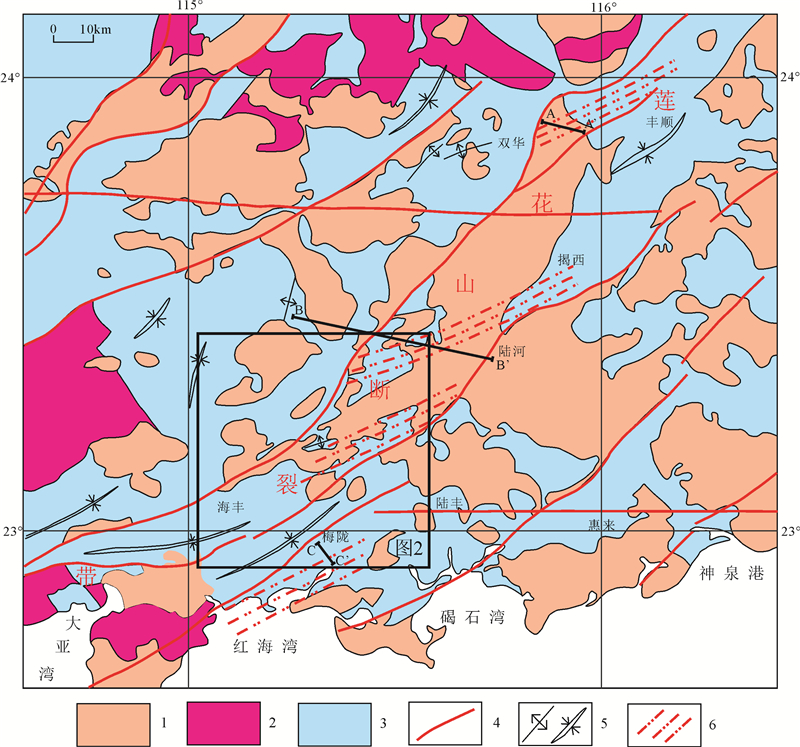
 下载:
下载:
